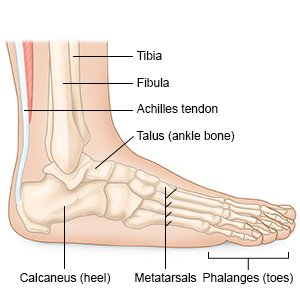Tarsal Tunnel Release
Medically reviewed by Drugs.com. Last updated on Apr 6, 2025.
What do I need to know about tarsal tunnel release?
Tarsal tunnel release is surgery to relieve pain and numbness from tarsal tunnel syndrome. The tarsal tunnel is between the bump on the inside of your ankle and ligaments stretched across your foot. Surgery takes pressure off a nerve in the tarsal tunnel.
 |
How do I prepare for surgery?
- Your surgeon will tell you how to prepare. He or she may tell you not to eat or drink anything after midnight on the day of surgery. Arrange to have someone drive you home when you are discharged from the hospital.
- Tell your surgeon about all medicines you currently take. He or she will tell you if you need to stop any medicine for surgery, and when to stop. He or she will tell you which medicines to take or not take on the day of surgery.
- Tell your surgeon about all your allergies, including to medicines or anesthesia.
- You may need to have nerve tests, an x-ray, or other tests to check your ankle. If you have diabetes, your A1c and blood sugar level may need to be checked.
Drugs used to treat this and similar conditions
Qutenza
Qutenza patches are used to treat neuropathic pain associated with postherpetic neuralgia and ...
L-Carnitine
L-Carnitine is used for carnitine deficiency, peripheral neuropathy
Ozempic
Learn about Ozempic (semaglutide) for type 2 diabetes treatment, weight management, cardiovascular ...
Carnitor
Carnitor is used for carnitine deficiency, peripheral neuropathy
Carnitor SF
Carnitor SF is used for carnitine deficiency, peripheral neuropathy
Phenytoin
Phenytoin is an anti-epileptic drug, also called an anticonvulsant. Learn about side effects ...
Capsaicin topical
Capsaicin information from Drugs.com, includes Capsaicin side effects, interactions and indications.
Carbamazepine
Carbamazepine is used to treat epileptic seizures and nerve pain such as trigeminal neuralgia ...
Levocarnitine
Levocarnitine systemic is used for carnitine deficiency, peripheral neuropathy
Pregabalin
Pregabalin may be used to treat certain types of pain and used in combination with other ...
What will happen during surgery?
Your surgeon may do open or endoscopic surgery. Open means he or she will make 1 incision in your ankle. Endoscopic means he or she will make 2 or 3 small incisions. Surgery will be done with tools put into the small incisions.
- You may be given general anesthesia to keep you asleep and free from pain during surgery. You may instead be given local anesthesia to numb the surgery area. With local anesthesia, you may still feel pressure or pushing during surgery, but you should not feel any pain. A band may be put around your leg to prevent bleeding.
- Your surgeon will cut a ligament in your ankle. This will relieve pressure being put on the tibial nerve. He or she may need to remove a bony growth or cyst causing your symptoms.
- An open surgery incision will be closed with stitches. Endoscopic incisions will be closed with medical tape. A bandage will be placed over the surgery area to prevent infection.
What should I expect after surgery?
- Medicines may be given to prevent or treat pain or a bacterial infection.
- You will need to move around after surgery to help prevent blood clots. You will not be able to put weight on your ankle, so you may be shown exercises to do in bed.
- You may not be able to put weight on your ankle until the surgery area heals. This may take 2 or 3 weeks. A splint will be put on your ankle to protect it and prevent movement. Then a physical therapist will teach you range of motion exercises for your ankle. You may also be able to use a walking boot so you can start to put weight on your ankle.
What are the risks of tarsal tunnel release?
You may bleed more than expected or develop an infection. A bone, artery, or nerves near the surgery area may be damaged. Surgery may not fully relieve the tarsal tunnel. You may continue to have pain or numbness in your ankle, foot, or toes. You may develop a condition called plantar fasciitis that causes pain in your heel.
Care Agreement
You have the right to help plan your care. Learn about your health condition and how it may be treated. Discuss treatment options with your healthcare providers to decide what care you want to receive. You always have the right to refuse treatment. The above information is an educational aid only. It is not intended as medical advice for individual conditions or treatments. Talk to your doctor, nurse or pharmacist before following any medical regimen to see if it is safe and effective for you.© Copyright Merative 2025 Information is for End User's use only and may not be sold, redistributed or otherwise used for commercial purposes.
Further information
Always consult your healthcare provider to ensure the information displayed on this page applies to your personal circumstances.
